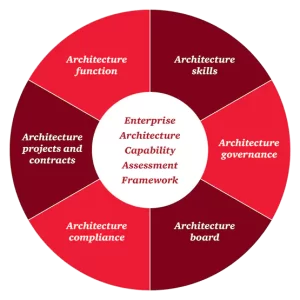
Enterprise Architecture
Enterprise Architecture (EA) aims at optimising legacy or fragmented processes, information and technology into an integrated environment that facilitates easy decision making and change implementation. An integrated technology environment (which includes business processes, data, technology and applications) can easily flex and respond to business demands and changes. This is because the impact of changes can be easily and quickly determined and the changes easily implemented and embedded across the enterprise.
Effective management and exploitation of information through technology is a key factor in driving business success, and a crucial means to achieving competitive advantage. You should not wait until you are embarking on a transformation or change journey to either put an EA function or assess your EA capability or compliance, this should already be built into your business as usual processes.
Key competencies
- Master of EA Frameworks (i.e. TOGAF, Zachman Framework)
- Uncovers operational gaps
- Analyzes information through data models and architecture diagrams
- Communicates the value of new IT strategies and keeps stakeholders informed of ongoing initiatives
When to act?
- According to architecture frameworks, Architecture Compliance reviews are required to be held at appropriate project milestones or at key phases of the project lifecycle including the initiation of the project, initial design phase, changes in key design and on an ad hoc basis.
- Architecture Compliance reviews should take place during the implementation of the enterprise architecture to ensure compliance with the developed architecture.
- The Architecture Compliance review is typically targeted for a point in time when business requirements and the enterprise architecture are reasonably firm, and the project architecture is taking shape, well before its completion.
- Compliance Review timelines are key and must be performed at points where major shortcomings or errors are able to be corrected.
What does good look like?

- An effective architecture capability must support the business and technology strategy – it does so by proactively identifying the direction of the business and technology, and ensuring that the organisation’s architecture is setup to support the achievement of these strategies.
- Principles that guides the implementation of architecture are unambiguous and non-contradictory.
- Projects that are implemented to deliver target architecture are well governed with inherent projects risks effectively managed.
- Skills to deliver and operate architecture are proactively determined, sourced and managed within the organisation.
- Architecture maturity is assessed periodically and benchmarked against industry standards to identify gaps that may require additional investment.
- Architecture governance is clearly defined, roles and responsibilities assigned and architecture risks managed.
- A timely, effective and robust architecture compliance process must be in place to identify any material gaps in implemented and planned enterprise architecture.
- Solution gaps should be identified early on for the implementation team to be fix promptly and avoid costly mistakes
How DBD can help?
DBD has developed an Enterprise Architecture Capability Assessment framework which can be used to assess the maturity of your organisation’s architecture function. Our framework has been designed to assess the robustness of your architecture capability framework across the following six areas:
- Architecture function
- Architecture projects and contracts
- Architecture compliance
- Architecture skills
- Architecture governance
- Architecture board
DBD has developed an Enterprise Architecture Compliance Assessment framework to assess the alignment of projects to an organisation’s architecture standards. Our framework has been designed based on established frameworks, such as TOGAF and COBIT, and through a DBD developed EA compliance review, can help in the following six ways:
- Tailored work programmes
- Confidence in your individual projects
- Provide challenge and scrutiny on the work undertaken by
the vendor and the system implementers; - Development experience for your EA team by
providing constructive feedback to the team; - Comfort over the compliance of individual projects in
achieving your EA goals - Likelihood a programme has of delivering to time and
to budget.
